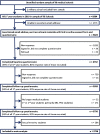Medical School Factors Associated with Changes in Implicit and Explicit Bias Against Gay and Lesbian People among 3492 Graduating Medical Students
- PMID: 28766125
- PMCID: PMC5653554
- DOI: 10.1007/s11606-017-4127-6
Medical School Factors Associated with Changes in Implicit and Explicit Bias Against Gay and Lesbian People among 3492 Graduating Medical Students
Erratum in
-
Correction to: Medical School Factors Associated with Changes in Implicit and Explicit Bias Against Gay and Lesbian People among 3492 Graduating Medical Students.J Gen Intern Med. 2018 Sep;33(9):1586. doi: 10.1007/s11606-018-4423-9. J Gen Intern Med. 2018. PMID: 29744718 Free PMC article.
Abstract
Background: Implicit and explicit bias among providers can influence the quality of healthcare. Efforts to address sexual orientation bias in new physicians are hampered by a lack of knowledge of school factors that influence bias among students.
Objective: To determine whether medical school curriculum, role modeling, diversity climate, and contact with sexual minorities predict bias among graduating students against gay and lesbian people.
Design: Prospective cohort study.
Participants: A sample of 4732 first-year medical students was recruited from a stratified random sample of 49 US medical schools in the fall of 2010 (81% response; 55% of eligible), of which 94.5% (4473) identified as heterosexual. Seventy-eight percent of baseline respondents (3492) completed a follow-up survey in their final semester (spring 2014).
Main measures: Medical school predictors included formal curriculum, role modeling, diversity climate, and contact with sexual minorities. Outcomes were year 4 implicit and explicit bias against gay men and lesbian women, adjusted for bias at year 1.
Key results: In multivariate models, lower explicit bias against gay men and lesbian women was associated with more favorable contact with LGBT faculty, residents, students, and patients, and perceived skill and preparedness for providing care to LGBT patients. Greater explicit bias against lesbian women was associated with discrimination reported by sexual minority students (b = 1.43 [0.16, 2.71]; p = 0.03). Lower implicit sexual orientation bias was associated with more frequent contact with LGBT faculty, residents, students, and patients (b = -0.04 [-0.07, -0.01); p = 0.008). Greater implicit bias was associated with more faculty role modeling of discriminatory behavior (b = 0.34 [0.11, 0.57); p = 0.004).
Conclusions: Medical schools may reduce bias against sexual minority patients by reducing negative role modeling, improving the diversity climate, and improving student preparedness to care for this population.
Keywords: longitudinal studies; medical education; prejudice; sexual minorities; sexual orientation.
Conflict of interest statement
The authors declare that they do not have a conflict of interest.
Figures
Comment in
-
Capsule Commentary on Phelan et al., Medical School Factors Associated with Changes in Implicit and Explicit Bias Against Gay and Lesbian People among 3492 Graduating Medical Students.J Gen Intern Med. 2017 Nov;32(11):1248. doi: 10.1007/s11606-017-4160-5. J Gen Intern Med. 2017. PMID: 28822044 Free PMC article. No abstract available.
-
Medical Education Then and Now.J Gen Intern Med. 2017 Nov;32(11):1163-1164. doi: 10.1007/s11606-017-4165-0. J Gen Intern Med. 2017. PMID: 28875254 Free PMC article. No abstract available.
-
Response to Capsule Commentary.J Gen Intern Med. 2018 Apr;33(4):403. doi: 10.1007/s11606-018-4313-1. J Gen Intern Med. 2018. PMID: 29383549 Free PMC article. No abstract available.
Similar articles
-
Contact and role modeling predict bias against lesbian and gay individuals among early-career physicians: A longitudinal study.Soc Sci Med. 2019 Oct;238:112422. doi: 10.1016/j.socscimed.2019.112422. Epub 2019 Aug 4. Soc Sci Med. 2019. PMID: 31391147 Free PMC article.
-
Do Contact and Empathy Mitigate Bias Against Gay and Lesbian People Among Heterosexual First-Year Medical Students? A Report From the Medical Student CHANGE Study.Acad Med. 2015 May;90(5):645-51. doi: 10.1097/ACM.0000000000000661. Acad Med. 2015. PMID: 25674910 Free PMC article.
-
The mixed impact of medical school on medical students' implicit and explicit weight bias.Med Educ. 2015 Oct;49(10):983-92. doi: 10.1111/medu.12770. Med Educ. 2015. PMID: 26383070 Free PMC article.
-
Training to reduce LGBTQ-related bias among medical, nursing, and dental students and providers: a systematic review.BMC Med Educ. 2019 Aug 30;19(1):325. doi: 10.1186/s12909-019-1727-3. BMC Med Educ. 2019. PMID: 31470837 Free PMC article.
-
Nursing Students' Attitudes Toward Lesbian, Gay, Bisexual, and Transgender Persons: An Integrative Review.Nurs Educ Perspect. 2016 May-Jun;37(3):144-52. doi: 10.1097/01.nep.0000000000000004. Nurs Educ Perspect. 2016. PMID: 27405195 Review.
Cited by
-
Medical Students' Demographic Characteristics and Their Perceptions of Faculty Role Modeling of Respect for Diversity.JAMA Netw Open. 2021 Jun 1;4(6):e2112795. doi: 10.1001/jamanetworkopen.2021.12795. JAMA Netw Open. 2021. PMID: 34086032 Free PMC article.
-
Characteristics, barriers, and career intentions of a national cohort of LGBTQ+ MD/PhD and DO/PhD trainees.BMC Med Educ. 2022 Apr 21;22(1):304. doi: 10.1186/s12909-022-03378-8. BMC Med Educ. 2022. PMID: 35449040 Free PMC article.
-
The Dissectionality of Care in the U.S.: A Scoping Review in Healthcare of Implicit Bias, Perceived Discrimination, and Minority Stress Among Sexual and Gender Minorities.Arch Sex Behav. 2025 Jun;54(6):2005-2041. doi: 10.1007/s10508-025-03155-w. Epub 2025 Jul 2. Arch Sex Behav. 2025. PMID: 40603819
-
LGBT+ Health Teaching within the Undergraduate Medical Curriculum.Int J Environ Res Public Health. 2019 Jun 28;16(13):2305. doi: 10.3390/ijerph16132305. Int J Environ Res Public Health. 2019. PMID: 31261831 Free PMC article.
-
Response to Capsule Commentary.J Gen Intern Med. 2018 Apr;33(4):403. doi: 10.1007/s11606-018-4313-1. J Gen Intern Med. 2018. PMID: 29383549 Free PMC article. No abstract available.
References
-
- Office of Disease Prevention and Health Promotion. Lesbian, Gay, Bisexual, and Transgender Health. [Webpage]. https://www.healthypeople.gov/2020/topics-objectives/topic/lesbian-gay-b.... 2017.
-
- 2014 National Healthcare Quality and Disparities Report. Rockville, MD: Agency for Healthcare Research and Quality; 2015.
-
- Committee on Lesbian G, Bisexual, and Transgender Health Issues and Research Gaps and Opportunities. The Health of Lesbian, Gay, Bisexual, and Transgender People: Building a Foundation for Better Understanding. Washington, DC: Institute of Medicine.
MeSH terms
Grants and funding
LinkOut - more resources
Full Text Sources
Other Literature Sources


